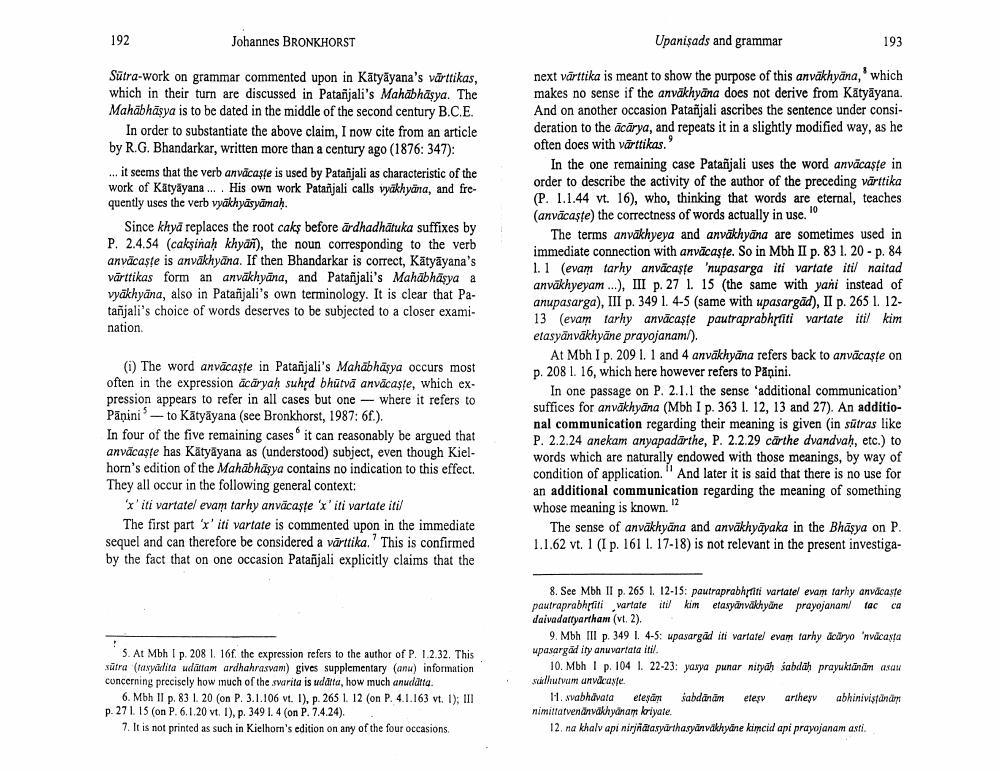Book Title: Upanisads And Grammar On Meaning Of Anuvyakhyana Author(s): Johannes Bronkhorst Publisher: Johannes Bronkhorst View full book textPage 4
________________ 192 Johannes BRONKHORST Upanişads and grammar 193 Sutra-work on grammar commented upon in Kätyāyana's vārttikas, which in their turn are discussed in Patanjali's Mahabhäsya. The Mahabhäsya is to be dated in the middle of the second century B.C.E. In order to substantiate the above claim, I now cite from an article by R.G. Bhandarkar, written more than a century ago (1876: 347): ... it seems that the verb anvācaste is used by Patanjali as characteristic of the work of Katyayana ... His own work Patanjali calls vyakhyāna, and frequently uses the verb vākhyāsyāmah. Since khya replaces the root caks before ārdhadhātuka suffixes by P. 2.4.54 (caksinah khyar), the noun corresponding to the verb anväcaste is anvākhyāna. If then Bhandarkar is correct, Katyāyana's vārttikas form an anvākhyāna, and Patanjali's Mahābhāsya a vyakhyana, also in Patanjali's own terminology. It is clear that Patañjali's choice of words deserves to be subjected to a closer examination next värttika is meant to show the purpose of this anvākhyāna,' which makes no sense if the anvākhyāna does not derive from Katyāyana. And on another occasion Patañjali ascribes the sentence under consideration to the ācārya, and repeats it in a slightly modified way, as he often does with vārttikas. In the one remaining case Patañjali uses the word anvācaste in order to describe the activity of the author of the preceding värttika (P. 1.1.44 vt. 16), who, thinking that words are eternal, teaches (anvācaste) the correctness of words actually in use." The terms anvākhyeya and anvākhyāna are sometimes used in immediate connection with anvācaste. So in Mbh II p. 83 1. 20 - p. 84 1.1 (evam tarhy anvacaste 'nupasarga iti vartate itil naitad anvākhyeyam ...), III p. 27 1. 15 (the same with yani instead of anupasarga), III p. 349 1. 4-5 (same with upasargad), II p. 265 1. 1213 (evam tarhy anväcaste pautraprabhraiti vartate itil kim etasyānvākhyāne prayojanam/). At Mbh I p. 209 1. 1 and 4 anvākhyāna refers back to anvācaste on p. 208 1. 16, which here however refers to Panini. In one passage on P. 2.1.1 the sense 'additional communication suffices for anvākhyāna (Mbh I p. 363 1. 12, 13 and 27). An additional communication regarding their meaning is given (in sütras like P. 2.2.24 anekam anyapadārthe, P. 2.2.29 cärthe dvandvah, etc.) to words which are naturally endowed with those meanings, by way of condition of application. And later it is said that there is no use for an additional communication regarding the meaning of something whose meaning is known." The sense of anvākhyāna and anväkhyāyaka in the Bhāsya on P. 1.1.62 vt. 1 (I p. 161 I. 17-18) is not relevant in the present investiga (i) The word anvācaste in Patanjali's Mahābhäsya occurs most often in the expression acāryaḥ suhd bhūtvā anväcaste, which expression appears to refer in all cases but one -- where it refers to Pāņini' - to Katyayana (see Bronkhorst, 1987:6f.). In four of the five remaining cases it can reasonably be argued that anvacaste has Katyayana as (understood) subject, even though Kielhorn's edition of the Mahābhāsya contains no indication to this effect. They all occur in the following general context: X'iti vartatel evam tarhy anvācaste 'x' iti vartate itil The first part x'iti vartate is commented upon in the immediate sequel and can therefore be considered a vārttika. This is confirmed by the fact that on one occasion Patanjali explicitly claims that the 5. At Mbh I p. 208 1. 16. the expression refers to the author of P. 1.2.32. This sūtra (rascadita udartam ardhahrasvan) gives supplementary (anu) information concerning preciscly how much of the syarita is udarta, how much anudarta 6. Mbh II p. 83 1. 20 (on P. 3.1.106 vt. 1). p. 265 1. 12 (on P. 4.1.163 vt. 1); III p. 271. 15 (on P. 6.1.20 vt. 1), p. 349 1. 4 (on P. 7.4.24). 7. It is not printed as such in Kielhor's edition on any of the four occasions 8. See Mbh II p. 265 1. 12-15: pautaprabhtiti vartatelevant tarhy anvdcaste patraprabhrfiti, vartate it kimetasyon váhyane prayojanam/ fac ca daivadattyartham (vt. 2). 9. Mbh III p. 349 1. 4-5: upasargad iti vartale evamt farhy dcdyo invacasta upasargad ity anwartata itil. 10. Mbh I p. 104 I. 22-23: yasya punar nityah sabah prayuktūnām asaw sudutum anvicasse 11. svabhavata eteşan sabdânām elesy arthey abhiniviständer nimittatvenanvākhyānam kriyale. 12. na khalv api nirjñātasyärthasyavakhyane kimcid api prayojanam asti.Page Navigation
1 2 3 4 5 6 7
